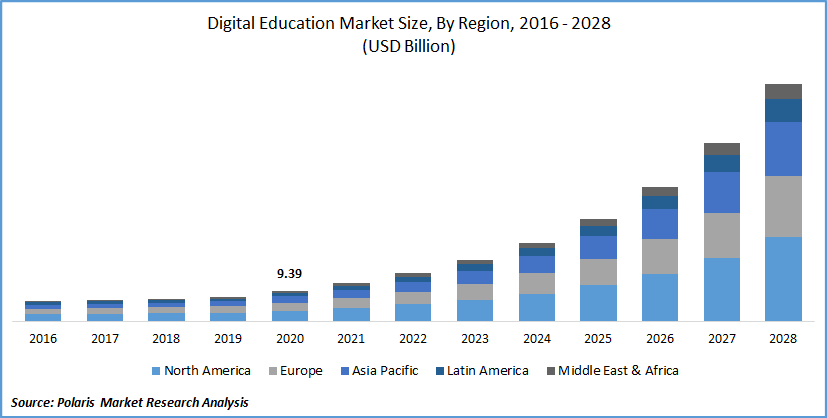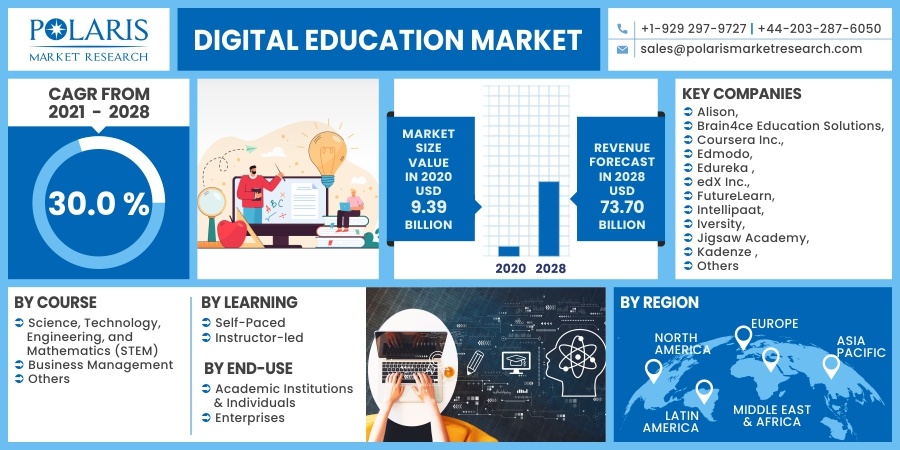
Digital Education Market Share, Size, Trends, Industry Analysis Report, By Course (Science, Technology, Engineering, Mathematics [STEM], Business Management, Others), By Learning (Self-Paced, Instructor-led), By End-Use (Academic Institutions & Individuals, Enterprises), By Region; Segment Forecast, 2021 - 2028
- Published Date:Oct-2021
- Pages: 111
- Format: PDF
- Report ID: PM2058
- Base Year: 2020
- Historical Data: 2016 - 2019
Report Outlook
The global digital education market was valued at USD 9.39 billion in 2020 and is expected to grow at a CAGR of 30.0% during forecast period. The growing network accessibility, internet facilities, and rising penetration of connected devices such as laptops, smartphones, tablets, etc., across the educational sector, are the factors contributing to the market growth. Personalized learning by the students and professionals, rising learning opportunities, improving thinking skills contribute to the adoption of digital education platforms.
Furthermore, the global digital schooling market also helps to reduce infrastructural expenditure, and rising scalability by using digital learning method act as a catalyzing factor for the market development across the globe.
 Know more about this report: request for sample pages
Know more about this report: request for sample pages
Industry Dynamics
Growth Drivers
Increasing adoption of digital education solutions for teaching various courses drives the market demand for digital education around the world. Digital education helps students by making easily concentrate on their studies as it offers the benefit of convenience. Further, during the online course program, students can presume to take necessary courses such as biology, MBA, BBA, CFA physics, chemistry, algebra, and calculus. Due to the availability of bulk courses, students who take these courses while pursuing a degree will be in a particular specialization.
Students who choose digital education as all these subject courses can be studied through online platforms. In addition, increasing market demand from academic and corporate institutions for cost-effective training and learning techniques coupled with the rising number of engineering institutions & universities is the major factor promoting the market growth of the sector worldwide. Some institutions that are offering digital education at low cost and or even free are Carnegie Mellon University, Delft University of Technology, Massachusetts Institute of Technology, University of California, University of Oxford, University of Cambridge, and others. As a result, the growing need for digital courses available at low cost compared to offline by the educational institutes aiding the growth of the market over the forecast period.
The Digital Education Market report details key market dynamics to help industry players align their business strategies with current and future trends. It examines technological advances and breakthroughs in the industry and their impact on the market presence. Furthermore, a detailed regional analysis of the industry at the local, national, and global levels has been provided

Know more about this report: request for sample pages
The COVID-19 outbreak causes a sudden shift away from classrooms in many areas in order to prevent the spread of coronavirus. Accordingly, it affects about 1.2 billion students from 186 countries due to the shutdown of schools. Thereby, market demand for the digital education platform increases, which, in turn, supports the market growth. Digital education offers e-learning solutions that provide a safe and convenient way of coaching during this pandemic and continuing student's schooling and classes. For instance, in April 2020, in South Korea, approximately 5.4 million scholars are opting live-streaming platforms such as Zoom and Google Classroom for learning lessons from home, as the country endeavors to avoid the growing coronavirus cases. Therefore, the widespread of the COVID-19 shows a positive influence on the global digital schooling market.
Report Segmentation
The market is primarily segmented on the basis of course, learning, end-use and region.
|
By Course |
By Learning |
By End-Use |
By Region |
|
|
|
|
Know more about this report: request for sample pages
Insight by Course
The Science, Technology, Engineering, and Mathematics (STEM) segment is the largest revenue generator by holding the largest revenue shares in the global market in 2020. Increasing market demand for STEM graduates in several industries and the growing need for technological developments boosts the segment demand.
In addition, STEM facilitates individuals for advancing natural tendencies by discovering and understanding the environment, improving understanding regarding the engineering design process, scientific reasoning, and applying mathematical & further critical thinking. Moreover, emerging technologies in the digital educational sector such as multimedia materials & classrooms assist in presenting easy understandings of complex STEM concepts to students. Therefore, this may create lucrative market growth of the segment across the globe.
The business management segment is expected to show the highest growth rate in the near future. Business management and other educators prefer AI-based classrooms for better understanding and ease of operational workflow. AI technology can automate organizational responsibilities instead of professionals spending their time on homework & grading, giving feedback on course quality, and personalized learning.
For instance, in January 2018, a chatbot was launched by Hubert.ai, which assists students and teachers in sharing their feedback about the professor and classes. The worth of the feedback is further proficient in comparison to the traditional way as chatbot incorporates AI technology. Therefore, these factors may fuel the market growth of the segment over the forecasting period.
Insight by Learning
The self-paced segment is the dominating segment that accounted for the highest shares in the global digital schooling market. The major characteristics of the segment comprise the creation of self-schedule, cost-effective, less pressure in live training, a suitable way for diverse learning patterns, and it is less distracting. For instance, YouTube is a major contributor to self-paced educational content. Further tools that encourage self-paced learning comprise GrammarFlip, Brain Pop, Kialo Edu, Knoword, Gimkit, and Education Galaxy. As a result, these attributing factors drive segment growth across the globe.
The instructor-led segment is estimated to show the highest CAGR in the approaching years. Segment refers to the training which consists one and more instructor that educates person or through presentations, lectures, discussions, and demonstrations. In certain situations, instructor teaches at the group at once, presenting various techniques such as exercises, games, as well as role-playing for enhancing the experience of learning through digital platforms. These are some prominent factors that fuel the market growth of the segment growth in the near future.
Geographic Overview
Geographically, North America is dominating the global digital education market with the highest shares in 2020. This is due to the quick acceptance of digital learning platforms across the region. Moreover, factors such as the partnership between network arenas and government as well as institutional collaboration between research professionals & digital education providers also foster the market growth in North America. The growing requirements for improving skill-sets of the technicalities and workforce in the organization for providing better learning outcomes among students, enforcing educational organizations for implementing digital education services & platforms. Therefore, due to the acceptance of new technologies, these factors act as catalyzing factors, leading the regional market growth.
Moreover, Asia Pacific is projected to grow at the highest CAGR across the globe in the approaching years. Factors such as increasing investment in outsourced digital education services, evolving technologies & network connectivity, and rising government education initiatives contribute to the market growth across APAC. In addition, emerging economies like China, India, South Korea, etc., have the potential to opt for e-learning due to the presence of large smartphone users.
For instance, In India PM eVidya Programme was introduced in May 2020. The aim of the program is to encourage digital education across the region, which was originally initiated by the union finance minister Nirmala Sitharaman. This scheme was taken to offer indefinite access to digital learning to scholars as well as teachers. Accordingly, these are some driving factors that fuel the growth of the digital education market in the forecasting years.
Competitive Landscape
Some of the major players operating the global digital education market include Alison, Brain4ce Education Solutions, Coursera Inc., Edmodo, Edureka, edX Inc., FutureLearn, Intellipaat, Iversity, Jigsaw Academy, Kadenze , Khan Academy , LinkedIn, Linkstreet Learning, NovoEd, Pluralsight LLC, Udacity, Inc., Udemy, Inc, XuetangX.
Digital Education Market Report Scope
|
Report Attributes |
Details |
|
Market size value in 2020 |
USD 9.39 billion |
|
Revenue forecast in 2028 |
USD 73.70 billion |
|
CAGR |
30.0 % from 2021 - 2028 |
|
Base year |
2020 |
|
Historical data |
2016 - 2019 |
|
Forecast period |
2021 - 2028 |
|
Quantitative units |
Revenue in USD million/billion Volume in kilotons and CAGR from 2021 to 2028 |
|
Segments covered |
By Course, By Learning, By End-Use, By Region |
|
Regional scope |
North America, Europe, Asia Pacific, Latin America, Middle East & Africa |
|
Key companies |
Alison, Brain4ce Education Solutions, Coursera Inc., Edmodo, Edureka , edX Inc., FutureLearn, Intellipaat, Iversity, Jigsaw Academy, Kadenze , Khan Academy , LinkedIn, Linkstreet Learning, NovoEd, Pluralsight LLC, Udacity, Inc., Udemy, Inc, XuetangX |
Navigate through the intricacies of the 2021 Digital Education Market with precision, thanks to the comprehensive statistics on market share, size, and revenue growth rate assembled by Polaris Market Research Industry Reports. This thorough analysis not only provides a glimpse into the historical context but also extends its reach with a market forecast outlook until 2028. Immerse yourself in the richness of this industry analysis by securing a complimentary PDF download of the sample report.
